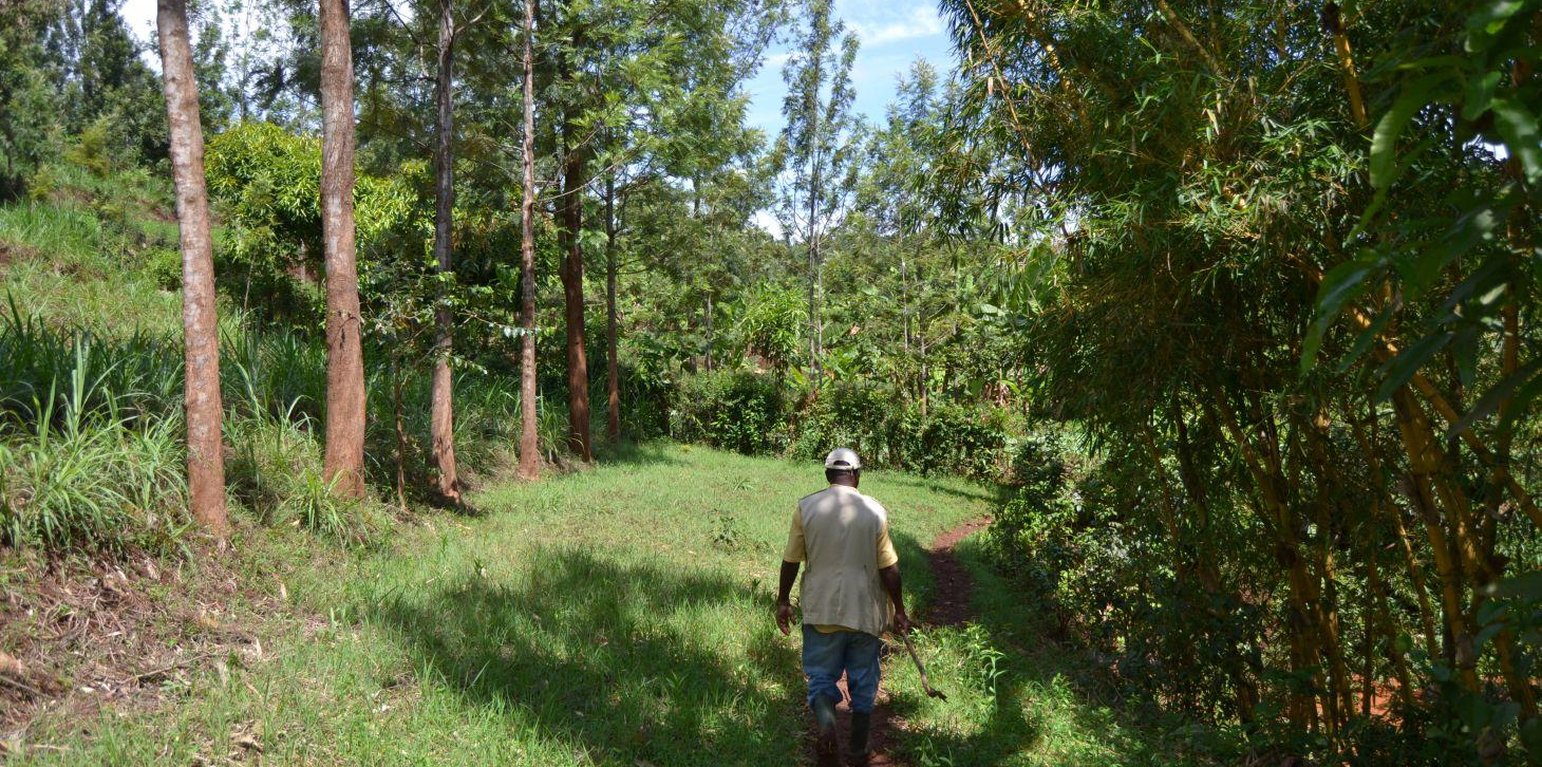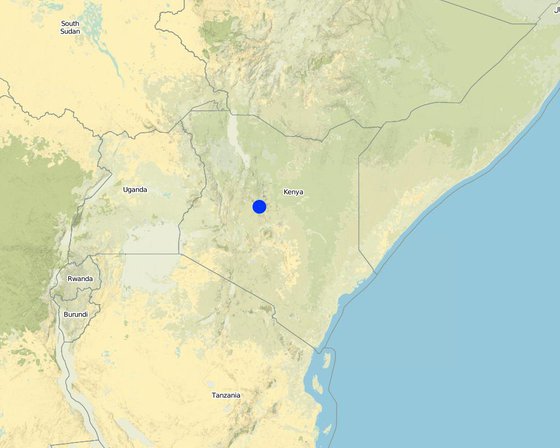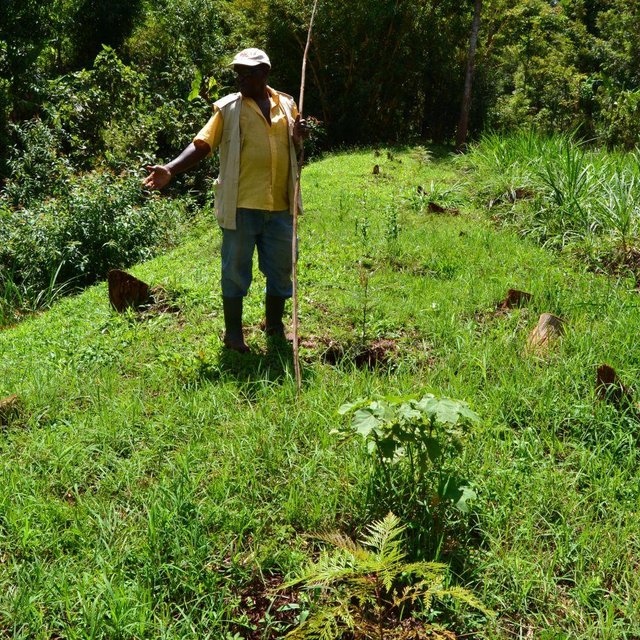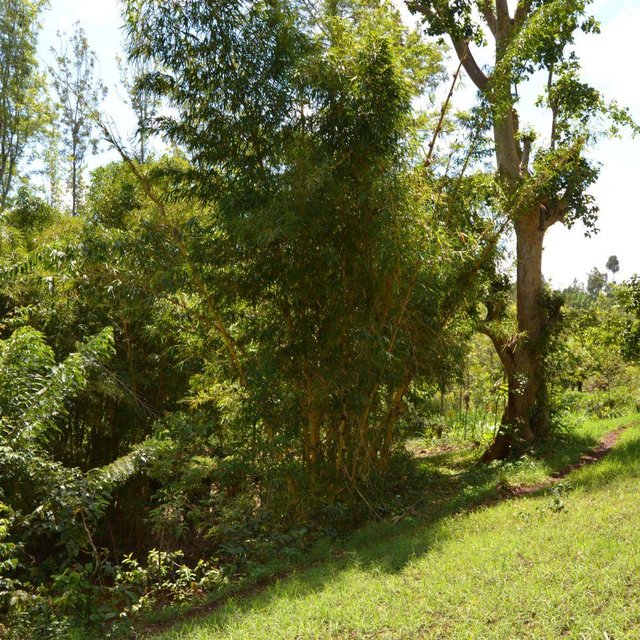



The practice carried out voluntary by the farmer consists of planting trees at the edge of the river bank and in its proximity.
Purpose of the Technology: By increasing vegetation cover (started 10 year ago) the intention of the farmer is to reduce and control bank erosion and landslides in the riparian land.
The degradation in this area is in fact evident and it is partially explained by the reduced vegetative cover. The planted trees help to maintain water quality by filtering silt and organic materials from rainwater runoff from the upper area and at the same time reinforce the streambank to control erosion. Another important environmental benefit is the increased carbon allocation from the new root systems.
The farmer also mentioned the interest to continue expanding tree plantation also in view of carbon credit and financial support from local authorities: in particular bamboo, which reaches maturity in few years, can be harvested after about two years and is easy to propagate (vegetatively).
Grevillea trees (timber) are seen by the farmer as a form of saving, and sold out when the farmer is in need of cash, earning between 800 up to 1500 KSh (Kenyan Shillings), depending on the size of the tree and the costs for cutting- transportation (e.g. machine operator between 500-700 KSh).
Establishment / maintenance activities and inputs: The initial inputs for the establishment of the vegetative practices concern mainly labour (e.g. planting trees) and the cost of the seedlings (10 KSh seedlings of Grevillea, 20 KSh of Guava); generally these activities are carried out at the beginning of the rainy season. Pruning of Grevillea is done every three seasons.
Natural / human environment: The climate is sub humid with two rainy seasons (the first starts around March and the second around October). Near the river the area is characterized by gentle slope and deposition of sediments and bank erosion are the main processes; the risks of further degradation and water pollution are reduced by the riparian vegetation and thanks to the good land management practices of the surrounding farmers. The riparian land is the area of min 6-30 m around the river and it is considered by law a protected area; therefore it should be left intact from any human activity (Water Act, 2002). Indeed, the 'control' and daily management is carried out by the riparian farmers in collaboration with Sabasaba WRUA and WRMA, the official authority for the management of the water of the river and the riparian land.
In this site in particular, the water of the river is considered clean by the farmer interviewed, despite the fact that during rainy seasons the sediment loads affect the quality of the water.

ទីតាំង: GATWAMIKWA village, Kagurumo sublocation, Muthithi location, Kenya, ប្រទេសកេនយ៉ា
ចំនួនទីកន្លែងបច្ចេកទេស ដែលវិភាគ:
ការសាយភាយនៃបច្ចេកទេស:
តើស្ថិតក្នុងតំបន់ការពារអចិន្ត្រៃយ៍?:
កាលបរិច្ឆេទនៃការអនុវត្ត: តិចជាង 10ឆ្នាំមុន (ថ្មី)
ប្រភេទនៃការណែនាំឱ្យអនុវត្តន៍៖







| បញ្ជាក់ពីធាតុចូល | ឯកតា | បរិមាណ | ថ្លៃដើមក្នុងមួយឯកតា (ដុល្លារ) | ថ្លៃធាតុចូលសរុប (ដុល្លារ) | % នៃថ្លៃដើមដែលចំណាយដោយអ្នកប្រើប្រាស់ដី |
| កម្លាំងពលកម្ម | |||||
| Digging holes | Persons/day | 4,0 | 1,75 | 7,0 | 100,0 |
| សម្ភារៈដាំដុះ | |||||
| Seedlings Grevillea | pieces | 25,0 | 0,28 | 7,0 | 100,0 |
| Seedlings Guava | pieces | 5,0 | 0,2 | 1,0 | 100,0 |
| ថ្លៃដើមសរុបក្នុងការបង្កើតបច្ចេកទេស | 15.0 | ||||
| ថ្លៃដើមសរុបក្នុងការបង្កើតបច្ចេកទេសគិតជាដុល្លារ | 15.0 | ||||
| បញ្ជាក់ពីធាតុចូល | ឯកតា | បរិមាណ | ថ្លៃដើមក្នុងមួយឯកតា (ដុល្លារ) | ថ្លៃធាតុចូលសរុប (ដុល្លារ) | % នៃថ្លៃដើមដែលចំណាយដោយអ្នកប្រើប្រាស់ដី |
| កម្លាំងពលកម្ម | |||||
| Pruning Grevillea | Persons/day | 1,0 | 4,0 | 4,0 | 100,0 |
| Clearing Grevillea for sale | Persons/day | 1,0 | 7,0 | 7,0 | 100,0 |
| ថ្លៃដើមសរុបសម្រាប់ការថែទាំដំណាំតាមបច្ចេកទេស | 11.0 | ||||
| ថ្លៃដើមសរុបសម្រាប់ការថែទាំដំណាំតាមបច្ចេកទេសគិតជាដុល្លារ | 11.0 | ||||
Could be the case for Napier grass if long dry spells occur
Indirectly another source of income that could improve in maintaining FS conditions at household level
The shared knowledge/benefits help to build community solidarity, strengthening linkages between farmers
The importance of the benefits of Bamboos and other sps. to the river in preventing erosion and improving water quality has encouraged neighbours to adopt the same veg. measures (fig. 8)
Especially Bamboo's canopy which create a good habitat for birds
Expanding bamboo's plantation could attract rodents/rats feeded off the bamboo's fruits, grains.
Beginning phase of the process of acquiring CC.